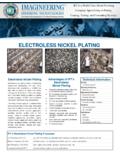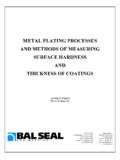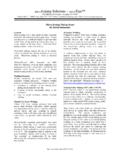Transcription of coatings for tooling - Beamalloy
1 Copyright, CSC Publishing. Tablets & Capsulescoatings for toolingIf tabletting equipment is the engine driving your manufactur-ing operation, you want to keep it running as smoothly andefficiently as possible. This article describes how specializedcoatings preserve and improve your tooling . It examines sev-eral coatings and coating methods and assesses the advantagesand disadvantages of H. DeutchmanBeamalloy TechnologiesChoosing coatings to improvethe performance of tablettoolingIndustrial processes, such as plastic molding and metalstamping, use engineered coatings to improve the perfor-mance of manufacturing tooling . These same coatingscan help tabletting tools resist corrosion and slow therate at which tool surfaces degrade, thus improving prod-uct quality and manufacturing productivity. The coatingscan also improve the performance of tablet press 9/1/04 4:57 PM Page 1 Copyright, CSC Publishing. Tablets & CapsulesTo take full advantage of these coatings , it s important tounderstand the surface interactions on the tablet toolface.
2 With this knowledge, you can choose a coating andcoating process that best meet your finish and tool performanceWhen you buy new tabletting punches from the man-ufacturer, they re free of wear and corrosion, and thepunch-cup surfaces are highly polished. As these punchescompress powders into tablets, the punch cup replicatesits surface finish on each tablet. Therefore, to ensuretablet quality, you must preserve the surface finish on thepunch cup. In addition, if the punch cup surface becomesabraded, scratched, or corroded, the roughened face cantrap small powder particles, which can lead to stickingand picking 1 shows the surface profiles of the polished areason the face of new and used tablet punch cups. The profileof the polished face of the new punch with a spectral(highly reflective) finish is very smooth and shows no fea-tures deeper or wider than micron. To see features thissmall requires very high magnification, 4,000 Xor you use the punch, the powder you re tablettingwill abrade the surface, and the spectral surface will even-tually appear matte.
3 This is caused by microscopicscratches and digs in the surface that are to wide and deep. To see these requires magnifica-tion of 750 Xor more. Large, hard granules in the powderor contaminants from buffing wheels (from punch manu-facture or routine maintenance) can produce even deeperscratches. To see them requires a magnification of 500 Xor more. Surface corrosion can leave very deep pits, someof them hundreds of microns in depth. It can also buildup oxide or sulfide scales on the surface. These you cansee with the naked mechanical the polishedsurfaces of the punches roughen, powders can becometrapped in mechanical surface imperfections. See Figure2. Over time, more powders will stick to these trappedparticles and will build up on the surface. Eventually,filming and sticking will appear, and you ll have to halttabletting to clean the , if the surfaces corrode and rust layers buildup on the punch surface, powders will stick to the rough-ened rust layers.
4 While detergents and solvents willremove the adhered powder, they won t restore the origi-nal finish to the punch surfaces. Instead, you may have tobuff out the scratches, pits, and corrosion layers torestore the surface finish in the tool you have to rely on buffing andpolishing to restore worn and corroded punch faces,your efforts will become counterproductive. Buffingcompounds contain abrasives that actually remove thinlayers of the metal surface to polish out scratches andpits. Repeated buffing can reduce the critical punchdimensions in the land area the area between the edgeof the punch cup and the outside diameter of the punchtip thus degrading the fit between the punch and buffing also rapidly degrades the aspect ratiosof the embossing on the punches. In short, buffing andpolishing dramatically reduce the service life of 1 Surface profiles across the faces of new and used tabletting punchesNew punchUsed punchesSurface profile(microns)Magnification requiredto see surfaceSpectral ( )4,000X(Hundreds)Scratched surface(1-10)500 XAbraded surfaceCorroded surfaceMatte ( )750 XNoneSmooth surfaced-Deutchmanart_16-27 9/1/04 4:57 PM Page 2 Copyright, CSC Publishing.
5 Tablets & CapsulesWear and corrosiondirectly decreasetablet quality, reducetabletting productiv-ity, and increase man-ufacturing the base metalsof tabletting tools areideal for the mechani-cal demands of tablet-ting, their surfaces canbe coatings ,if chosen and appliedproperly, are an excel-lent means of improv-ing resistance to wearand requirements for tablet tool coatingsTabletting punches are precision tools, and no coatingor coating process can be allowed to compromise theiroriginal properties. Table 1 lists engineering requirementsfor tablet punch coatings . To apply a coating successfully,you must be aware of these , coatings must notdegrade the original spectral finish on the cup that roughen the surface, even though theymay be hard, will promote mechanical adhesion of pow-ders to the punch. coatings must be harder than themetal used to makethe punch to bolsterwear must adherewell to the cup sur-face so that theydon t chip or coatings mustbe free of pinholesand voids to offer abarrier to , the coatingsmust be chemicallyinert to satisfy Foodand DrugAdministration(FDA) and currentGoodManufacturingPractice (cGMP) related to punch coat-ing process must not reduce the hardness of the processing temperatures can soften the punch, thusweakening such key surfaces as the land area and domedhead.
6 You must also maintain the physical dimensions ofthe punch during coating . Excess heat can easily distortkey dimensions, such as overall length, so that theyexceed critical tolerances. Certain plating processesapply coatings non-uniformly, leaving too thick a coat-ing on sharp land edges and on the 1 Engineering requirements for tablet punch coatingsSurface-related propertiesBenefitsNon-degraded surface finish in cupNo mechanical interlocking of powderIncreased surface hardnessImproved wear resistanceGood coating adhesionNo flaking or chippingNo pits or voids in the coatingContinuous corrosion barrierChemically inert coatingMeets FDA and cGMP guidelinesBulk-related propertiesHardness of barrelNo tempering or softeningOverall dimensionsNo distortionLand areaNo asymmetric buildupFigure 2 Powder entrapment on punch cup surfacesRoughened punch face surfaced-Deutchmanart_16-27 9/1/04 4:57 PM Page 3 Copyright, CSC Publishing. Tablets & CapsulesCoating processesOf the many coating processes in the industrial mar-ketplace, three are commonly used on tablet tooling :1.
7 Chemical plating2. Physical vapor deposition (PVD)3. Ion-beam-enhanced deposition (IBED)All the available coatings are deposited by one ofthese three basic processes. Metallic coatings , such asnickel (Ni) and chromium (Cr), are deposited either byelectroless electroplating (Ni) or electroplating (Cr).Materials such as boron (B) and Teflon (polytetrafluo-roethylene, or PTFE) can be added to Ni to enhanceplated coating hardness and coating lubricity, respec-tively. Processing temperatures during plating are below200 F, but the coated tool must be baked after plating athigher temperatures (375 F) to prevent hydrogenembrittlement (Cr), or at temperatures between 650 Fand 900 F to achieve full hardness (Ni).Hard refractory nitride coatings include titaniumnitride (TiN), chromium nitride (CrN), and diamond-like carbon (DLC). These are usually applied by PVD coatings , consisting of a layer of TiNwith CrN overcoat, are also possible.
8 They are known assuperlatticecoatings. To ensure good adhesion and opti-mum coating properties, the PVD processing tempera-ture must be 900 F or more. Those temperatures willsoften the tooling material and distort the precisiondimensions of the punch. Fortunately, you can also applythese nitride coatings with a low-temperature IBED process, which coats the tooling at temperatures below200 F. This eliminates the danger of softening anddimensional distortion of the punch. An IBED coatingsystem is pictured on page 17. Table 2 summarizes themajor features of the three coating nature of the coating processyou select determines the physical structure of the coat-ing, and the physical structure determines such key prop-erties as adhesion and smoothness. Figure 3 shows dia-grams of the coating structures obtained with plating,PVD, and IBED. Electroplated and electroless-platedcoatings are precipitates from aqueous solutions and thusgrow as individual grains on the surface.
9 The grainsnucleate randomly on the surface and grow together,eventually forming a continuous coating , although voidsand pits may remain in the coating as it grows. Adhesionis mechanical, thus the punch requires mechanical orchemical surface roughening before plating. PVD coatings are grown in a vacuum, using a high-temperature, chemically reactive vapor. They grow epi-taxially that is, the grains grow at slightly different ori-entations and at different rates, depending on themetallurgical composition of the area to be is chemical and relies on high-temperatureapplication to form a bond between the coating and thesubstrate. IBED coatings are also deposited in a vacuum,but the growth is atomistic, meaning that the coatingdoesn t grow as individual grains, and is nearly amor-phous and free of voids. Adhesion occurs by injecting thecoating into the surface (the case layer). The coatingthen grows from the case layer so that there is no distinctinterface between the coating and the substrate.
10 Becausekinetic energy generates the case layer and forms thecoating, the processing temperature remains below 200 surface 4 shows theappearance of surfaces coated by plating, PVD, andIBED. The coatings were applied to discs of M-serieshigh-speed steel (Rockwell C hardness of 62) that werepolished to a spectral finish before being coated. Theimages are taken from an electron microscope at a magni-fication of 2,500X. The electroplated Cr was buff-pol-ished after plating, but still shows the pits and voids thatform between the individual grains of Cr. This is charac-teristic of the plating process. The diameter of the pits is1 micron or less, so after polishing, this Cr-plated surfacewill not be prone to mechanical interlocking of electroless Ni coating shows grains 10 to 15microns in diameter. After deposition, the coating wasinfused with PTFE and baked. As you can see in Figure 4,there are small grains of PTFE on the Ni surface.







